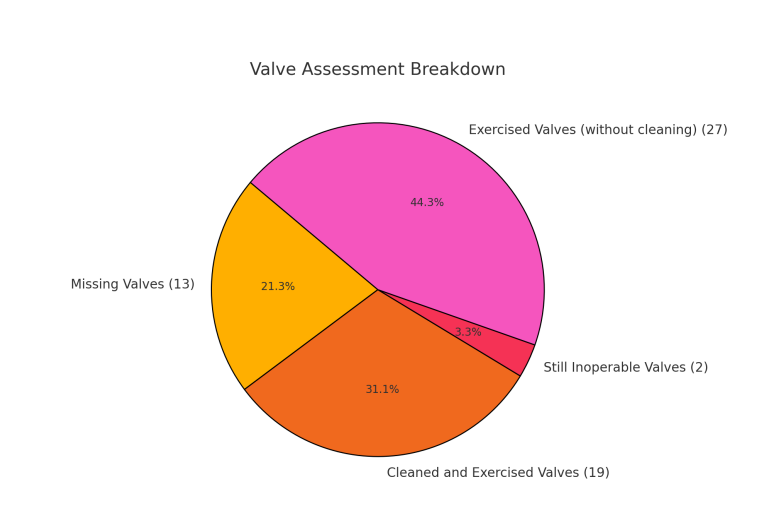Municipality Valve Assessment Report
Municipality Success Story Report
Mickie Service Company was contracted by a large municipality to locate and exercise valves within a specified neighborhood. This report outlines the activities undertaken, including the identification, status, and any issues encountered during the exercise of these valves.

Summary of Activities
- Expected Valves: 41
○ These are the valves we identified based on the map provided before scouting (may be skewed due to graphics on map covering each other) - Total Valves Identified: 61
○ The number of valves we found after scouting the neighborhood in addition to
valves identified on the original map that were unfound. - Total Findable Valves: 48
○ All originally identified and additional found valves, not including unfindable
valves.
○ 7 valves were not easily findable, but were located with a metal detector and
uncovered. (some grassed over, others had landscaping bushes) - Missing Valves: 13
○ Valves that were documented on the original provided valve map that were
unfindable. - Valves Unable to be Exercised: 2
○ Valves that were found but unable to be exercised for various reasons - Valve Stacks Cleared: 19
○ These were the valves that were found with water or dirt in the stack. They
required excavation to be operated, and are now clean and operable. - Valves Successfully Exercised: 46
○ Valves that were located, marked, cleaned (if necessary), and exercised.
Detailed Findings
- Found Valves Unable to be Exercised
These valves were found, but unable to be turned for a variety of reasons:- This valve stack was too deep for our vacuum excavator to reach, therefore the stack could not be cleared. Without being able to clear the stack, we were
unable to operate. - The valve stack had shifted leading the wall of the valve stack to be too close to the nut of the valve, making it unable to be fitted with a valve key and inoperable
- This valve stack was too deep for our vacuum excavator to reach, therefore the stack could not be cleared. Without being able to clear the stack, we were
- Missing Valves
These are valves that were identified on the original map provided by the city that were unable to be found after a given amount of time with the metal detector searching thearea. This may be due to the valve lids being paved over or covered by landscaping. We label these as inoperable because if they are needed, yet not able to be found, they cannot be operated. There Were 13 total missing valves. - Other Notable Valves
Valves 39 and 40 on the corner of Bayou Dr and Bayou St. John were both found mostly closed. Upon request, they were returned to the open position.
Key Areas of System Improvement
- Valve Identification:
- Before the Project: The original map indicated 41 valves, but there were concerns about completeness.
- After the Project: Our team identified 61 valves, identifying 20 additional valves that were not initially expected. This results in a 48.78% increase in the total number of valves identified. This high number may be due to valve icons
covering each other in the original map. - Impact: Identifying more valves increases the network's controllability, enabling better isolation of sections for repairs, thus reducing service disruptions.
- Valve Operability (Exercise Rate):
- Before the Project: Initially, it was unknown how many valves were functional.
- After the Project: Out of 61 identified valves, 46 valves were successfully exercised, achieving a 75.41% operability rate for all found valves.
- Impact: Exercising the valves ensures they are operable during emergencies (e.g., leaks, breaks), improving overall system functionality and responsiveness.
- Valve Stack Clearance:
- Before the Project: Many valves were obstructed by dirt or water, limiting their accessibility.
- After the Project: Our team cleared 19 valve stacks, which were previously inaccessible, bringing them back into operation.
- Impact: This clearance directly restored 19 valves that could not have been used in their previous state, which enhances system control and reduces the risk of water supply
interruptions. - System Functionality Enhancement (Findable Valves):
○ Findable Valves: Out of the 61 total identified valves, 48 were findable and accessible (excluding the 13 missing ones). - Operational Improvement:
- 46 out of 48 findable valves were exercised, giving a 95.83% operability for the findable valves.
- Impact: This high operability of findable valves ensures that almost all accessiblevalves in the network are functional and can be relied upon for system maintenance or emergency responses.
Advice from Experts
Summary of Functional Improvements:
● Valve Identification: 48.78% increase in total valves identified, improving network control points. (May be biased due to original map graphics)
● Operability: 75.41% of all identified valves are now operable, significantly improving the network's flexibility and emergency response capacity.
● Valve Stack Clearance: 19 valves were rehabilitated through cleaning, which would otherwise remain inoperable and limit system effectiveness.
● Missing Valves: Although 13 valves are still missing, this represents an opportunity for further improvement.
Recommended Next Steps
● Find or replace Valve #42 – as this appears to be the biggest exposure.
● Assess all missing broken valves to assess impact on emergency shut-down
● Excavate/fix #19 & #21
● Place concrete pads around all that currently do not have them (may need to discuss with citizens – who may not want this in the front yard)
● Re-map City valve map to show updated locations (adding GPS coordinates) – TBD if “missing valves” should be removed from the map – or just annotated as such.
● Establish an annual maintenance program – ensuring valve stacks are cleaned/valves exercised.
